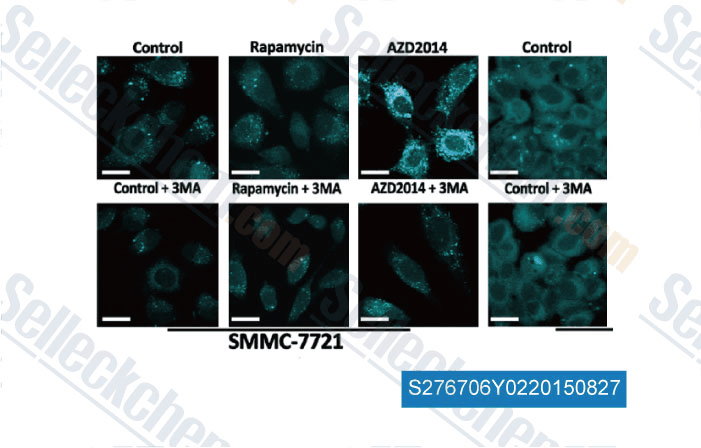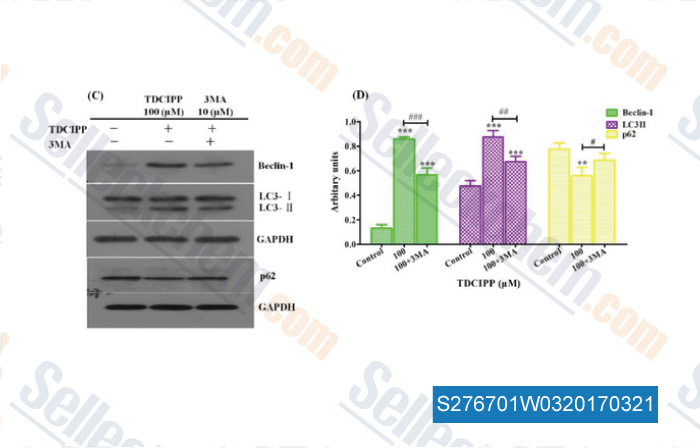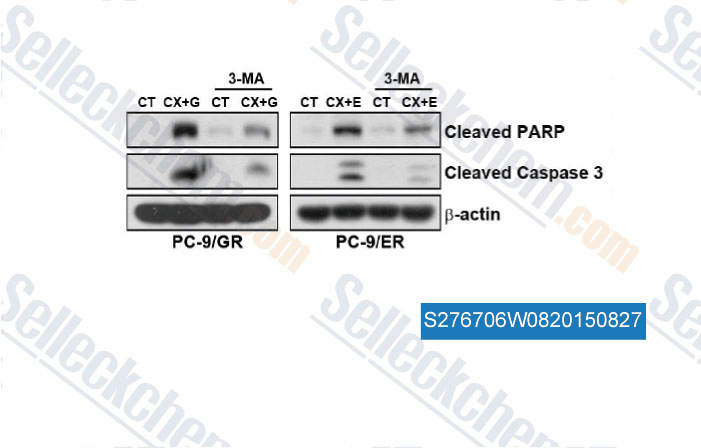|
Toll Free: (877) 796-6397 -- USA and Canada only -- |
Fax: +1-832-582-8590 Orders: +1-832-582-8158 |
Tech Support: +1-832-582-8158 Ext:3 Please provide your Order Number in the email. |
Technical Data
| Formula | C6H7N5 |
|||
| Molecular Weight | 149.15 | CAS No. | 5142-23-4 | |
| Solubility (25°C)* | In vitro | DMSO | 10 mg/mL (67.04 mM) | |
| Ethanol | 10 mg/mL (67.04 mM) | |||
| Water | 4 mg/mL (26.81 mM) | |||
|
* <1 mg/ml means slightly soluble or insoluble. * Please note that Selleck tests the solubility of all compounds in-house, and the actual solubility may differ slightly from published values. This is normal and is due to slight batch-to-batch variations. * Room temperature shipping (Stability testing shows this product can be shipped without any cooling measures.) |
||||
Preparing Stock Solutions
Biological Activity
| Description | 3-MA (3-Methyladenine) is a selective PI3K inhibitor for Vps34 and PI3Kγ with IC50 of 25 μM and 60 μM in HeLa cells; blocks class I PI3K consistently, whereas suppression of class III PI3K is transient, and also blocks autophagosome formation. Solutions are unstable and should be fresh-prepared. | ||||||
|---|---|---|---|---|---|---|---|
| Targets |
|
||||||
| In vitro | The slight preference for Vps34 prevention by 3-Methyladenine probably arises from a hydrophobic ring specific to Vps34, which encircles the 3-methyl group of 3-Methyladenine. [1] 3-Methyladenine has been reported to cause cancer cell death under both normal and starvation conditions. 3-Methyladenine could also suppress cell migration and invasion independently of its ability to inhibit autophagy, implying that 3-Methyladenine possesses functions other than autophagy suppression. 3-Methyladenine elicits caspase-dependent cell death that is independent of autophagy inhibition. Treatment with 5 mM 3-Methyladenine reduces the percentage of glucose-starved HeLa cells displaying GFP-LC3 puncta to 23%. The levels of LC3-I are increasing and the levels of LC3-II are decreasing between 12 and 48 hours in cells that are treated with 3-Methyladenine. Conversion of LC3-I to LC3-II is suppressed by 3-Methyladenine. Treatment of HeLa cells with 3-Methyladenine at 2.5 mM or 5 mM for one day does not affect cell viability, whereas treatment with 10 mM 3-Methyladenine for one day causes a 25.0% decrease in cell viability. Treatment of cells with 2.5, 5 or 10 mM 3-Methyladenine for two days causes 11.5%, 38.0% and 79.4% decrease in viability, respectively. 3-Methyladenine decreases cell viability in a time- and dose-dependent manner. 3-Methyladenine significantly shortens the duration of nocodazole-induced-prometaphase arrest. [2] Suppression of autophagy by 3-Methyladenine inhibits SU11274-induced cell death. [3] Prolonged treatment with 3-Methyladenine (up to 9 hours) induces significant LC3 I to II conversion in wild type MEFs. Prolonged treatment with 3-Methyladenine, but not wortmannin, markedly increases GFP-LC3 punctuation/aggregation. 3-Methyladenine-induced LC3 conversion and free GFP liberation are ATG7-dependent. 3-Methyladenine treatment leads to evident increase of p62 protein level. 3-Methyladenine increases the p62 level even in Atg5−/− MEFs as well as in cells with DOX-mediated deletion of ATG5. 3-Methyladenine inhibits class I and class III PI3K in different temporal patterns. 3-Methyladenine-induced LC3 I to LC3 II conversion is dramatically compromised in Tsc2−/− cells compared with wild type cells.3-Methyladenine disrupts the anti-autophagic function of mTOR complex 1. [4] |
||||||
| In vivo | 3-Methyladenine blocks autophagy through its effect on class III phosphatidylinositol 3-kinase (PI3K). 3-Methyladenine treatment does not alter the degree of hemorrhage compared with the subarachnoid hemorrhage (SAH) group. 3-Methyladenine pretreatment significantly aggravates neurological symptoms when compared with the SAH + vehicle group. Autophagy is decreased when 3-Methyladenine treatment is applied. Conversely, cleaved caspase-3 is markedly up-regulated in the SAH + 3-Methyladenine group. In line with the up-regulation of cleaved caspase-3 expression, the number of TUNEL-positive cells in the right cortex is significantly increased in the SAH + 3-Methyladenine group compared with the SAH + vehicle group. [5] |
Protocol (from reference)
| Kinase Assay: |
|
|---|---|
| Cell Assay: |
|
| Animal Study: |
|
References
Customer Product Validation

-
Data from [Data independently produced by , , Redox Biol, 2018, 18:138-157]

-
Data from [Data independently produced by , , Am J Cancer Res, 2015, 5(1): 125-139]

-
Data from [Data independently produced by , , Food Chem Toxicol, 2017, 100:183-196]

-
Data from [Data independently produced by , , PLoS One, 2014, 9(12): e114000 ]
Selleck's 3-MA (3-Methyladenine) has been cited by 950 publications
| Engineered a dual-targeting HA-TPP/A nanoparticle for combination therapy against KRAS-TP53 co-mutation in gastrointestinal cancers [ Bioact Mater, 2024, 32:277-291] | PubMed: 37876556 |
| Gonococcal OMV-delivered PorB induces epithelial cell mitophagy [ Nat Commun, 2024, 15(1):1669] | PubMed: 38396029 |
| Sonic hedgehog restrains the ubiquitin-dependent degradation of SP1 to inhibit neuronal/glial senescence associated phenotypes in chemotherapy-induced peripheral neuropathy via the TRIM25-CXCL13 axis [ J Adv Res, 2024, S2090-1232(24)00106-1] | PubMed: 38479571 |
| Inhibiting autophagy enhanced mitotic catastrophe-mediated anticancer immune responses by regulating the cGAS-STING pathway [ Cancer Lett, 2024, 586:216695] | PubMed: 38325769 |
| IL-33 Accelerates Chronic Atrophic Gastritis through AMPK-ULK1 Axis Mediated Autolysosomal Degradation of GKN1 [ Int J Biol Sci, 2024, 20(6):2323-2338] | PubMed: 38617533 |
| Acetylation of MOB1 mediates polyphyllin II-reduced lysosome biogenesis in breast cancer by promoting the cytoplasmic retention of the YAP/TFEB coactivator complex [ Phytomedicine, 2024, 10.1016/j.phymed.2023.155152] | PubMed: 37922793 |
| Silica nanoparticles induce ferroptosis of HUVECs by triggering NCOA4-mediated ferritinophagy [ Ecotoxicol Environ Saf, 2024, 270:115889] | PubMed: 38150751 |
| Inhibition of RIPK1 alleviating vascular smooth muscle cells osteogenic transdifferentiation via Runx2 [ iScience, 2024, 27(2):108766] | PubMed: 38318355 |
| MicroRNA-141-3p reduces pulmonary hypoxia/reoxygenation injury through suppression of Beclin-1-dependent autophagy [ Aging (Albany NY), 2024, 16(2):1352-1373] | PubMed: 38261732 |
| Autophagy plays a pro-apoptotic role in arsenic trioxide-induced cell death of liver cancer [ J Integr Med, 2024, S2095-4964(24)00044-X] | PubMed: 38599914 |
RETURN POLICY
Selleck Chemical’s Unconditional Return Policy ensures a smooth online shopping experience for our customers. If you are in any way unsatisfied with your purchase, you may return any item(s) within 7 days of receiving it. In the event of product quality issues, either protocol related or product related problems, you may return any item(s) within 365 days from the original purchase date. Please follow the instructions below when returning products.
SHIPPING AND STORAGE
Selleck products are transported at room temperature. If you receive the product at room temperature, please rest assured, the Selleck Quality Inspection Department has conducted experiments to verify that the normal temperature placement of one month will not affect the biological activity of powder products. After collecting, please store the product according to the requirements described in the datasheet. Most Selleck products are stable under the recommended conditions.
NOT FOR HUMAN, VETERINARY DIAGNOSTIC OR THERAPEUTIC USE.
